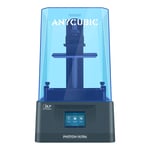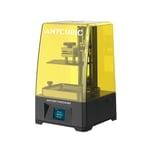Anycubic is a brand that’s more inextricably linked to the success of desktop resin 3D printing than many give credit. The company’s original Photon 3D printer packaged a prohibitively priced printing process into a sub-$1,000 body, and people lapped it up. Pre-Elegoo, pre-Phrozen. It was the first.
But being the first doesn’t necessarily make you the best, just bold. It feels a little like that again, with Anycubic now pushing DLP-based desktop 3D printing in the Photon D2. It’s taken something known and prohibitive and made it affordable for a new audience.
One key difference here though is that the Photon D2 is entering a thriving market populated with inexpensive and excellent machines. It needs to stand out. With a price tag just shy of $700, it’s a tough sell.
Verdict
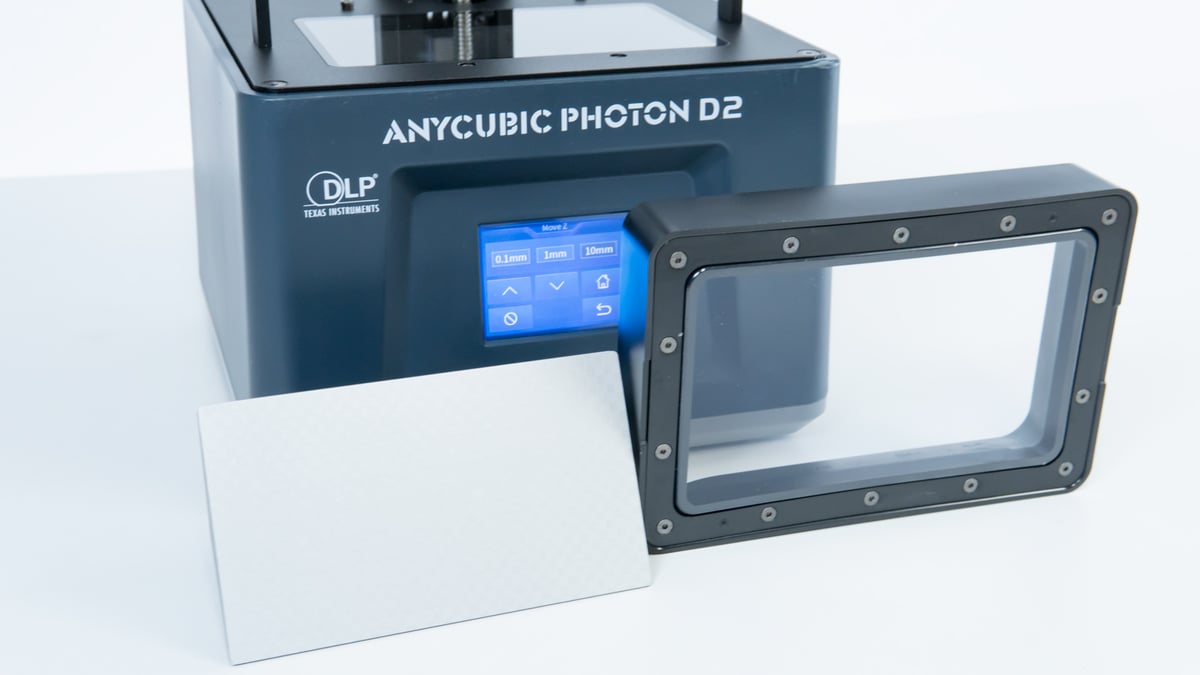
Pros
- No medium-term consumables
- Comparatively low energy consumption
- Captures fine detail
- Familiar to users of any desktop LCD systems
Cons
- Small build volume
- No compelling advantage over LCD systems
- Detail is “soft” compared to crispness of high-res LCD systems
The Anycubic Photon D2 is a bit odd. On paper, it’s underpowered, with a resolution that would’ve been top-notch three years ago. Through fancy tech trickery, though, it performs on par with today’s top LCD-based printers. Print details look a little softer, but it’s competitive. It lacks the luxuries of many of its LCD-based peers, but its light engine should last longer than those machines. Unfortunately, you’ll only see a cost-benefit of this longevity through intensive, long-term use.
It prints well, but for the time it’ll take the choice of DLP over LCD to pay off, plus nearly every other aspect being bang average, the D2 is, sadly, not worth the $679 ask.

The Tech
The Photon D2 is only the second true DLP 3D printer from Anycubic and joins a growing roster of resin printing machines dominated by LCD technology.
What this means for you in real terms, is not much. You can use the same resins and print the same models. And the print preparation workflow is identical to any modern LCD-based resin 3D printer.
So why should we care about the Photon D2 or DLP in general? Let’s dig a little into what makes it unique.
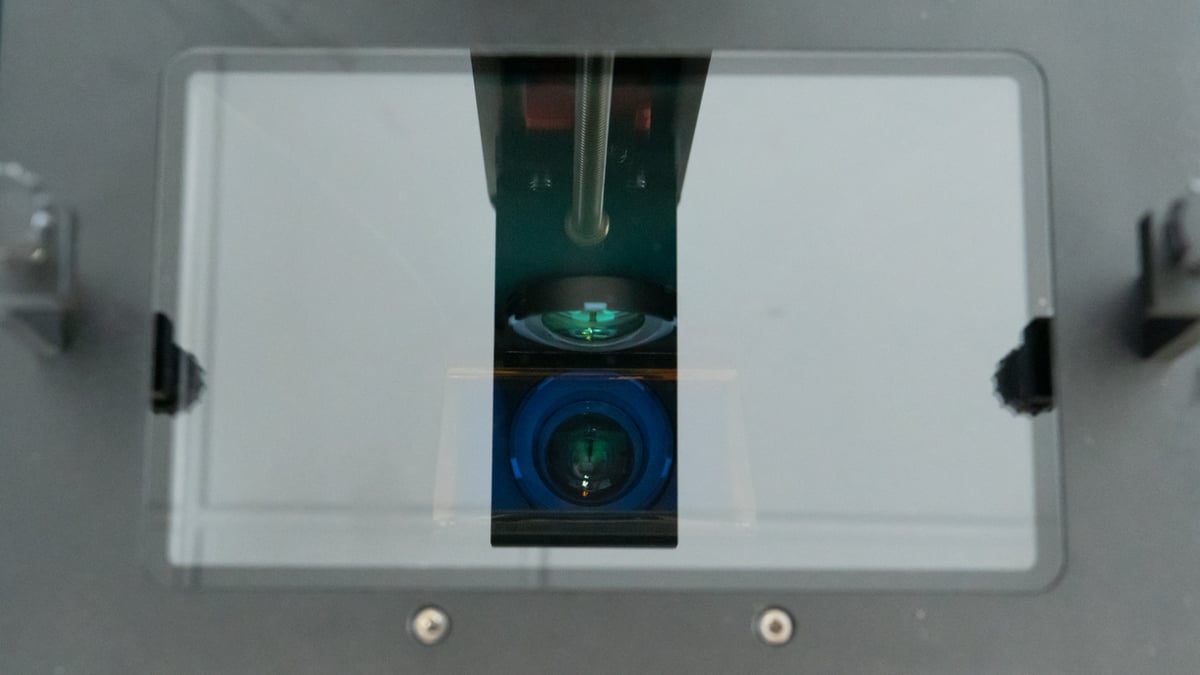
What’s different about the D2?
For starters, you can run the Photon D2 much longer than any LCD-based 3D printer without opening it up to replace degraded components. The big claim of the D2 is a lifespan of 20,000+ hours for its Texas Instruments DLP projector. Compare that to the ~2,000 hours you get from a monochrome LCD standard on desktop resin printers today, and the magnitude of the difference is clear.
We can’t test this, of course. It’d take over 800 days of non-stop use to come even close. At the time of writing, you couldn’t buy spare projectors on the Anycubic website, and we suspect you won’t ever be able to, what with intermittent usage unlikely to even touch the sides of the stock projector’s lifespan. The makings are there for the D2 to be the resin 3D printer for stable, long-term use.

And it’s oh so quiet (shhh, shhh, Björk fans). The technomological makeup of the D2’s Texas Instruments projector and digital micromirror device (DMD) requires no active cooling, which means the obnoxious drone of a cooling fan is absent. The result is unsurprising – it’s a whisper-quiet machine. You can only hear the faint mechanical hum of the print plate moving for each layer.
Another claim for the Photon D2, which is more significant in today’s climate than at any other time in desktop 3D printing’s short lifespan, is energy efficiency. Anycubic claims the Photon D2 practically sips energy, compared to its gigajuice guzzling LCD-based brethren. With electricity costs spiraling in some countries, we can see the value in this. More so when this energy efficiency doesn’t come at the expense of print performance.
You could even take the position that the D2 performs better – there’s a parity of print quality with top LCD-based printers, and it’s quieter and more energy efficient doing it. This efficiency doesn’t really excuse it costing a good lump more than top LCD printers, nor it being achingly ordinary in almost every regard.
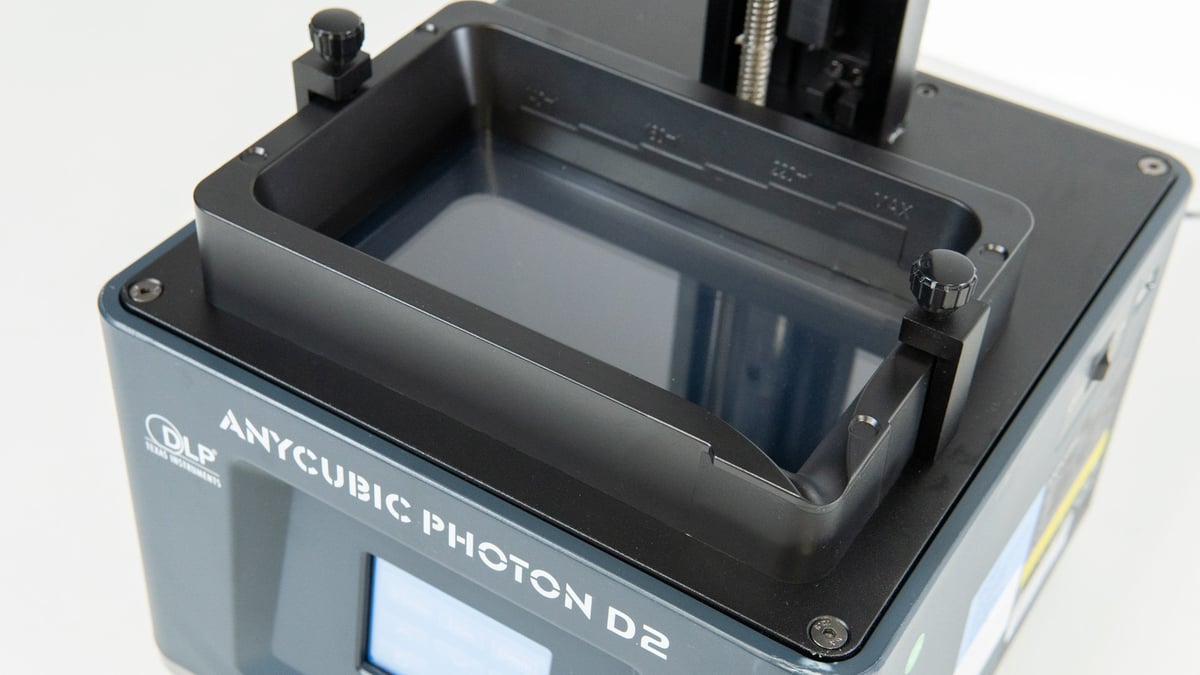
If you’re set on desktop DLP printing, you can compare the Photon D2 to its predecessor, the Photon Ultra. The D2 has a 55% larger build area (62% larger build volume) and doubles the effective resolution.
Pixel Shifting
The spec sheet of the Photon D2 reads a little dull. For $679, you get a 165 x 73 x 131 mm print volume, which is longer but narrower and shorter than the $209 Elegoo Mars 3’s 143 x 89 x 175 mm.
The Photon D2 also has an effective resolution of 2560 x 1440 pixels, which puts it at “2K”, yesterday’s resolution standard for this class of machine. Anycubic dismisses this potential flaw, choosing instead to focus on how well the Photon D2 handles anti-aliasing to close the gap and eliminate the jaggies.

The underlying tech inside the Photon D2 is worth exploring to better appreciate what exactly the printer is and does.
For starters, the Photon D2’s Texas Instruments’ DLP projector uses something called expanded pixel resolution (XPR), which takes the existing array of pixels (or corresponding mirrors, to be precise) and shifts them very, very quickly. These mirrors each bounce a pixel’s worth of light to a spot on the resin vat, so by spacing them out and moving them quickly, you can simulate extra pixels in the “gaps”.
An additional benefit of this technology, Anycubic says, is that DLP offers linear control of the UV light’s brightness when doing anti-aliasing. Using this technology instead of an LCD with backlighting UV LEDs lets the Photons D2 achieve better surface quality, with less noticeable stepping between the voxels of a print.

We mentioned earlier that the Photon D2’s effective resolution is 2560 x 1440 pixels. It doesn’t actually have that many pixels (mirrors) at its disposal. We were surprised to learn that the DMD chip inside is the same 1280 x 720 unit found in the Photon Ultra, just with the extra stuff to let it shift the pixels.
Further technological tidbits of the Photon D2 include the tiniest, pokiest of touchscreen interfaces, which seems a huge, dropped ball. Anycubic could have differentiated the D2 as a luxurious machine with a feeling to go with the price tag. But they didn’t.

Print job transfer uses a USB thumb drive. It seems that the drive is read constantly and gets pretty toasty when left idle in the machine for a long time. We suspect this is not ideal for the lifespan of the stick nor the data stored on it and could indicate an issue with the port. We’ll update this review with more detail if we get to the bottom of this.

Printing & Usability
So, the Photon D2 is smart with its parts, making more from less. You could liken it to engine development in cars. Advances give more power and efficiency from less fuel; it doesn’t necessarily impact the performance and is economical.
But what’s the Photon D2 like to use as a resin 3D printer? Well. It’s par for the course. There are no innovations in usability, and the standard stuff is a bit… meh.
Setting the printer up is a matter of establishing a new “zero” for the print plate. Leveling the print plate fixture is a standard four-screw setup. After removing the resin vat, you loosen the screws, send the print plate down to rest atop a sheet of paper (provided with the printer), press down firmly, and tighten the screws.
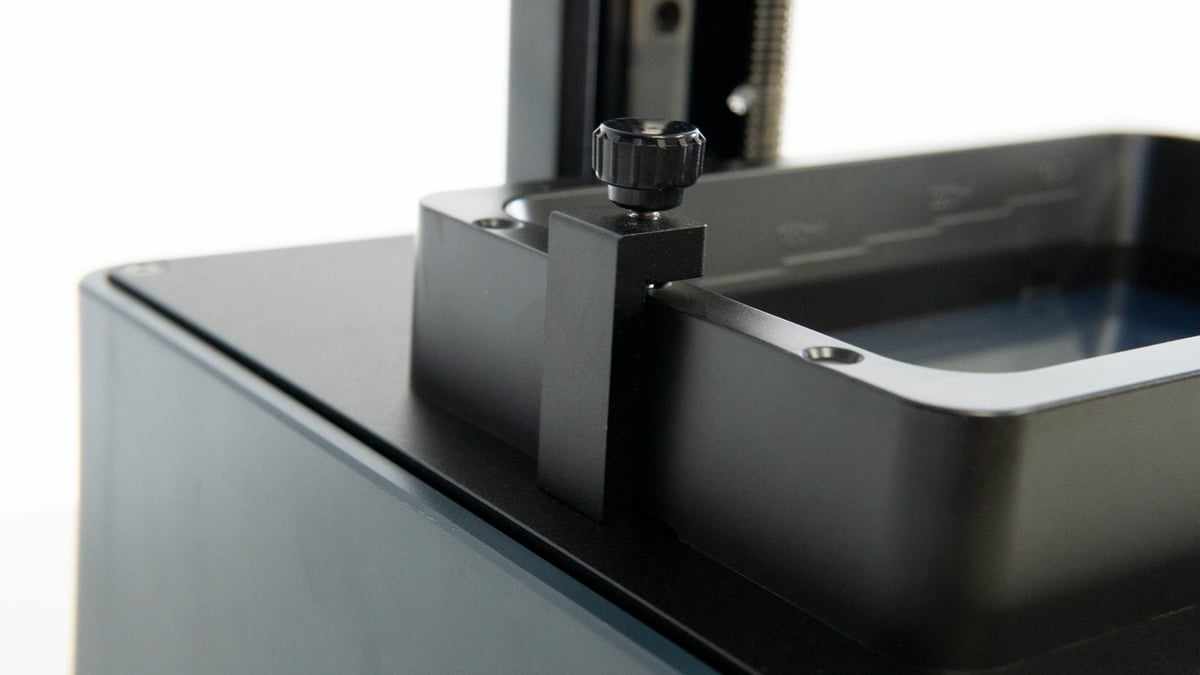
The resin vat nestles into a slight recess in the print chamber, which helps you when securing, and the thumbscrews fasteners drop down from adjacent pillars to fix it in place. Recesses on top of the vat’s frame irritatingly collect resin spills, too.
The print plate fixture has some play to it that inadvertently lets you pivot the plate as you tighten the fixing screw. While we experienced no poor plate adhesion in our time testing, that the plate can be locked in slightly different positions is surely not a good thing for repeatability.
As mentioned before, the touchscreen is a pokey little number and a letdown for the asking price of the machine. It’s responsive, though, and Anycubic’s standard interface is easy to navigate and gives you a (tiny) preview of the model when you load a print from the USB stick. Note that the displayed image generates when you hit “slice” in your slicing software. It takes a snapshot of your view inside the slicer when you do, so if you want to see the model clearly on the Photon D2’s dinky display, reorient your viewport in the slicer before slicing to give yourself a clear view.
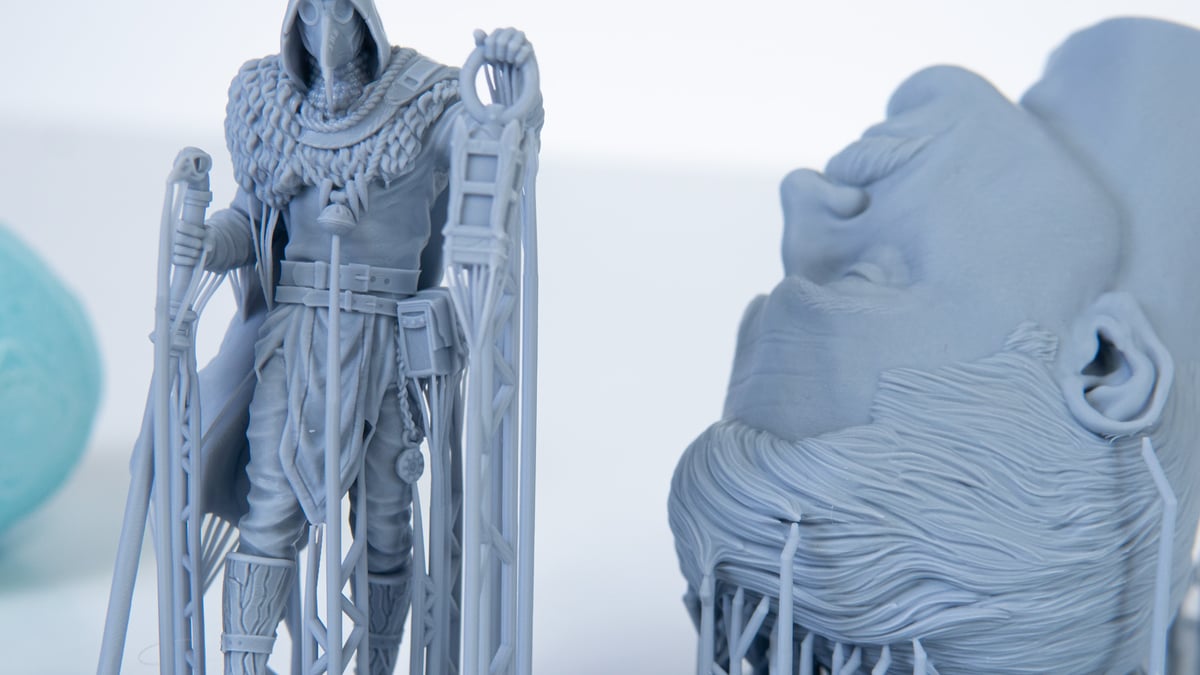
Barebones
There aren’t really any luxuries with the Photon D2. You get no air filtration unit (though honestly, we question the genuine benefit of the USB-powered charcoal filters provided in many printers nowadays – always print in a well-ventilated space). Likewise, there’s no auto-resin feed as found with the slightly cheaper Anycubic Photon M3 Plus or the newer, and again, cheaper, Photon M3 Premium.
The resin vat doesn’t feature pegs to rise off messy surfaces, and the USB port is on the side of the machine, increasing its total footprint.
There’s no Wi-Fi connectivity. Mercifully, some months after launch, a multitude of slicers now support the Photon D2, giving you flexibility in your print prep.
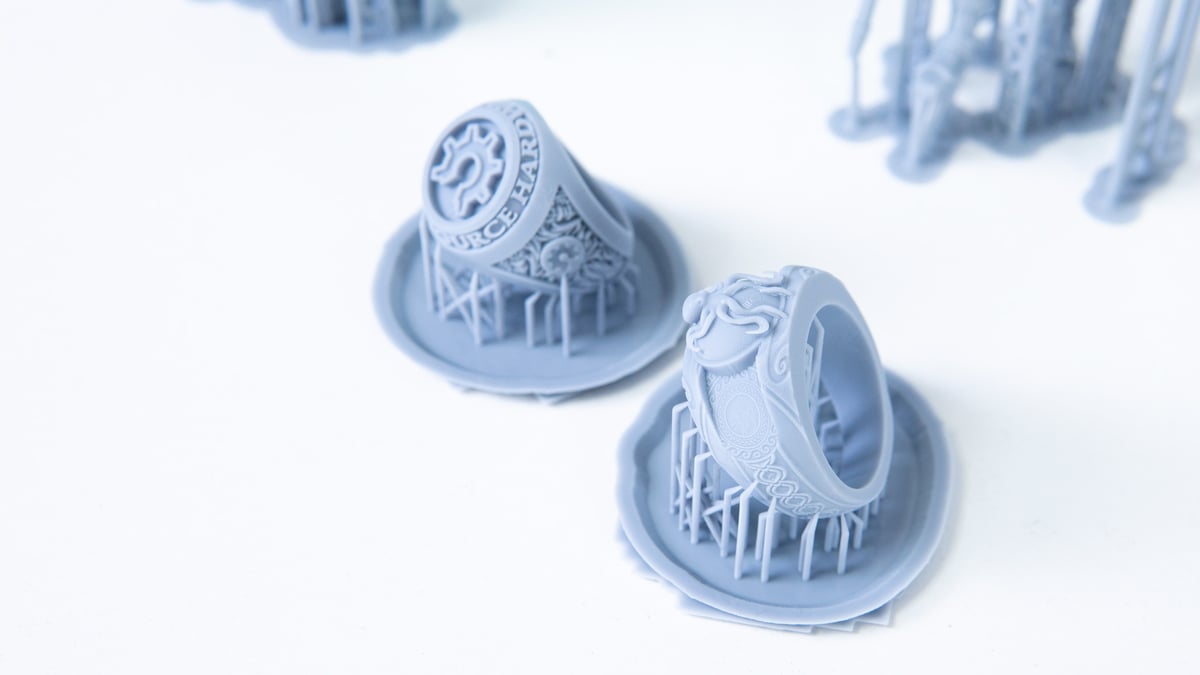
Only Anycubic’s own Photon Workshop offers the 16x anti-aliasing that Anycubic claims let the Photon D2 further punch above its weight for print quality. Unfortunately, auto-support generation in Photon Workshop is flakey, so you’ll have to spend more time manually setting a print up to take full advantage of this.
One small plus in the Photon D2’s corner is the print plate texture, which has a gorgeous checkerboard pattern and adheres to prints well, but not too well, making removal a piece of cake.
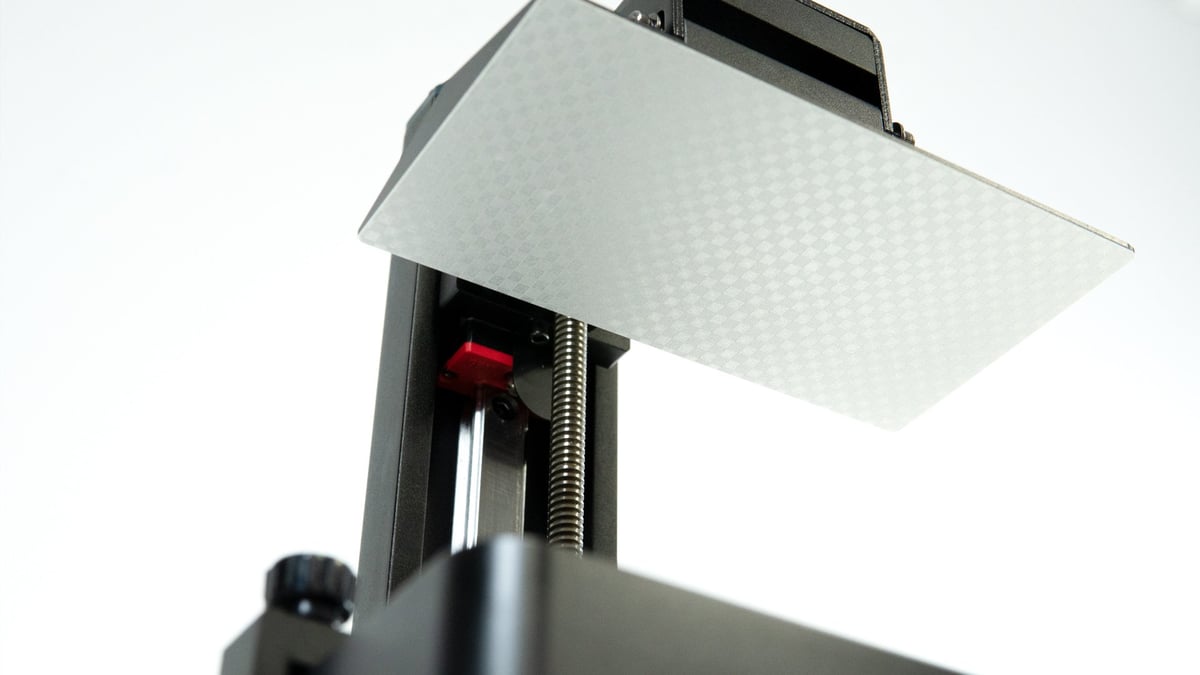
Your material choices using the Photon D2 are wide open – the printer is compatible with resins for LCD-based machines. Anycubic also sells a DLP-specific resin called Craftsman. While no specific claims are given for the material’s performance, resins formulated for particular machines or technologies can perform more reliably, benefitting from a chemical makeup tuned to the lighting the machine offers.
Projection Power
The prints you make with the Photon D2 are undeniably beautiful. Despite being “only 2K” in effective resolution, such terms are pretty meaningless in resin printing when you can barely distinguish between these prints or those made with a current, high-res LCD-based printer.
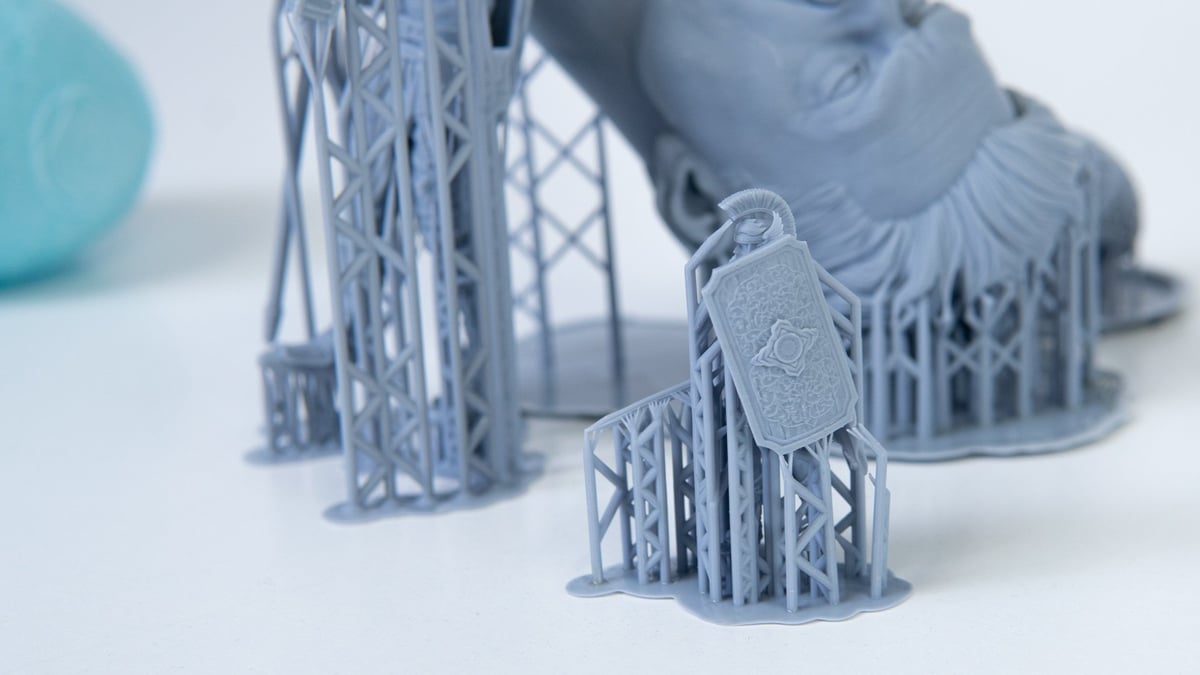
We ran the Photon D2 using Anycubic’s recommended anti-aliasing settings side-by-side with the Phrozen Sonic Mini 8K, a machine with a pixel resolution that theoretically approaches four times that of the D2, and the only difference to note is that of softness in some details with the D2’s prints. It’s not that things wash out – textures and fine features captured by the 8K machine are also present here, but a barely perceptible sharpness is lost with the Photon D2. This is, perhaps, a sign of the D2’s anti-aliasing performance hitting a little too hard.
Anycubic paints a picture of this printer being the machine for artists, jewelers, and even dentists. The experience of using it is no different from the swathe of inexpensive LCD systems that dominate the desktop resin 3D printing landscape, so perhaps there’s something going for it if a barely perceptible softness is what you need in your prints.

Is It Worth It?
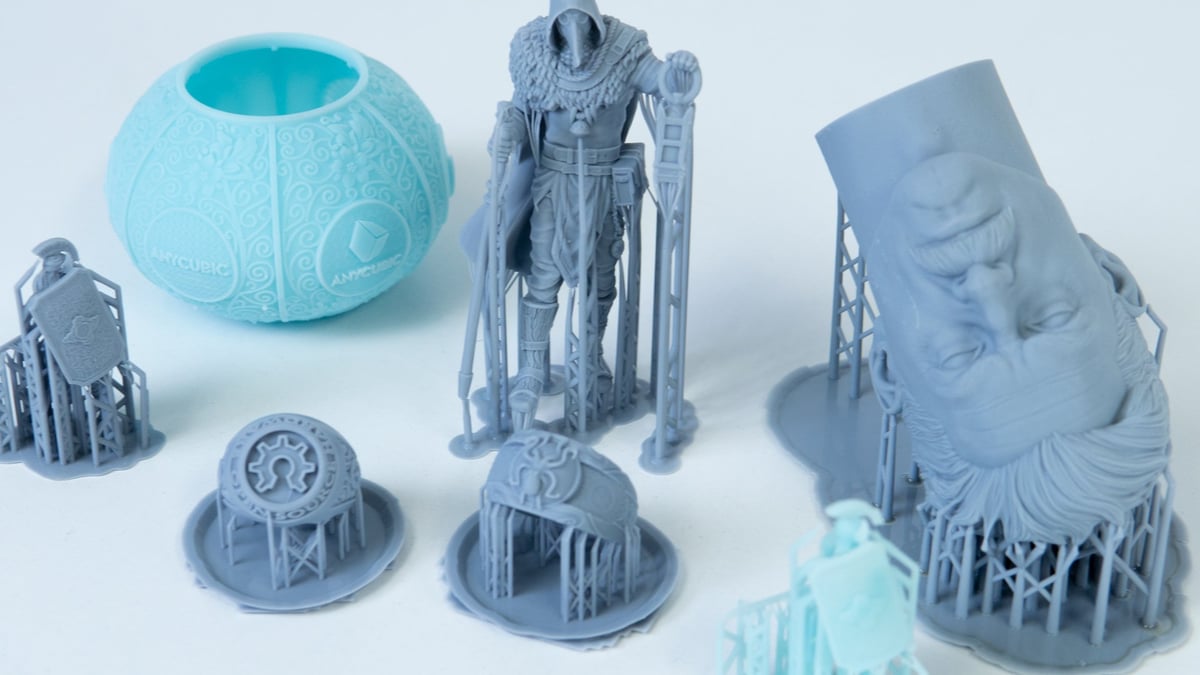
The Anycubic Photon D2 is a tricky machine to grade. It has some clever tech inside, allowing it to perform up to the grade of top LCD machines in its class while being quieter and using less power. The lifespan of the DLP projector inside will long outlive any LCD panel, cutting back on e-waste, not to mention it requires less maintenance from the user. These address some of the weaknesses of LCD-based printers, undoubtedly.
As much as we’d love for all of the above to become the new norm, the Photon D2 doesn’t quite add up enough for us to recommend it against the sheer variety and sophistication of the top LCD-based 3D printers available today.
At $679, you’re paying a premium for unusual tech and miss out on the newer advances and features that make desktop resin printing easier and more convenient; we’re talking resin auto-feeders, wireless connectivity, large build volumes – things that are present on many of Anycubic’s newer Photon 3D printers but absent from the Photon D2.

Anycubic doesn’t make things easier, too. The company releases new printers at a frightening pace. Case in point: while testing the Photon D2, the M3 Premium landed in our lap – a larger LCD-based machine with all the conveniences listed above. Its cost? $619 – undercutting the D2 by $60.
Ultimately, it seems the actual value of the Photon D2 lies in whether you plan for printing in the long term. If you know that you will be printing a lot for many years to come and want to avoid the cycle of upgrading to the latest features and trendy specs, it could make economic sense.
The Photon D2 is a functional printer, and while the resolution behaves differently from what you would expect of an LCD printer, it is not, optically, a step-down. It’s simple to use and produces great-looking prints. The trouble is that last statement applies to everything else these days, and (mostly) everything else costs less money and has greater utility and comfort features.
Unless your conscience tells you to make the greener choice (which we commend – the Photon D2 won’t disappoint), there’s better value elsewhere.

Features
2K 498ppi Projector
The Photon D2 has a 2K projector, meaning its voxels (the 3D equivalent of a pixel) are arranged 2560 x 1440 with a maximum density of 498 ppi. Maximum PPI is especially important here as DLP PPI is subject to change as the projector zooms in and out.
With these specs, Anycubic says the printer can keep up with the likes of 8K LCD 3D printers. This despite a maximum XY accuracy of 51 microns appearing in Anycubic’s slicer for the Photon D2, while 8K machines like the Sonic Mini 8K boast a significantly better 22-micron accuracy.
Our initial testing found that the Photon D2 keeps up with the Sonic Mini 8K. Likely due to the fundamental differences between the two technologies.
Larger Build Volume
Chief among Anycubic’s updates since its previous attempt at a DLP 3D printer is the D2’s increased build volume. The Photon D2 has a 131 x 73 x 165 mm build volume. Nothing to phone home about, but it’s a reasonable volume for a resin 3D printer that brings in more in line with consumer expectations, we’d say. Good to see this DLP offering more in line with users’ needs.
Anti-Aliasing Algorithm
However accurate your 3D printer might be, it’s always going to build parts in layers, and those layers are probably going to be visible in your final print. Anycubic is trying to reduce layer lines – or eliminate them outright – with its new anti-aliasing algorithm.
Just like in computer graphics, anti-aliasing is a term representing the elimination of the staircase effect and smoothing of an object’s curves. If it works well, it’ll go a long way in making 3D printed objects look more natural and dramatically reduce post-processing; a huge boon to anyone creating small, detailed objects like miniatures or jewelry.
20,000-Hour Service Life
There should be little need for maintenance with the D2 as Anycubic is promising a 20,000-hour service life – 10x longer than a typical monochrome LCD screen.
This sort of long service life is typical for DLP 3D printers and one of the reasons it’s so exciting to see affordable options hitting the market. The D2 does have a modest life in terms of DLP, with other options like the ~$4,000 Flashforge Hunter being serviceable for 50,000 hours, but given the price difference and market, the D2 seems to offer plenty of uptime.
Further Features
Those are the key takeaways for the Anycubic Photon D2, but there are a few more features you might be interested in:
- Quiet operation: We’ve already experienced just how quiet the D2 is during process. Apparently, this printer doesn’t generate enough heat from its light source to require a fan.
- Low energy consumption: The Photon D2 only requires 15 watts of power, a quarter of an LCD printer’s required power, Anycubic says, though slightly higher than the Ultra’s 12 watts.
- Laser-engraved build surface: For a little sticky assistance, Anycubic has laser engraved the build surface with a checkerboard pattern.

Featured Prints
We’re not talented enough to create fabulous 3D printable models to put the printers we test through the wringer, so we turn to the wealth of outstanding models available on popular repositories. Here’s everyone featured in our imagery for this review.
Tech Specs
General Specifications
- Technology: DLP
- Type: Resin
- Year: 2022
- Assembly: Fully assembled
- Manufacturer: Anycubic
3D Printing Specifications
- Build Volume: 131 x 73 x 165 mm
- Layer Height: 10 microns
- XY Resolution: 51 microns (2,560 x 1,440 pixels)
- Z positioning accuracy: 0.1 mm
- Printing Speed: < 50 mm/h
- Bed Leveling: Manual
- Display: 2.8-inch touchscreen
- Third-Party Materials: Yes
- Materials: 405 nm UV resin
Software Requirements
- Recommended Slicer: Anycubic Photon Workshop
- Operating System: Windows / macOS
- File Types: STL
- Connectivity: USB
Dimensions and weight
- Frame dimensions: 236 x 226 x 438 mm
- Weight: 4 kg
Similar Printers
If the Anycubic Photon D2 doesn’t seem like quite what you’re looking for, or you’re just a bit impatient, there are plenty of other resin 3D printer options out there. Below are three models we think are particularly enticing, but also be sure to check out our list, The Best Resin 3D Printers in 2024 – Buyer's Guide.
Anycubic Photon Ultra
If you’re in a rush and are set on a DLP 3D printer, there aren’t many options around in the budget market. The only one currently available is the D2’s predecessor: the Photon Ultra.
As we’ve covered, the D2 has improved on the Ultra with a larger build volume and higher precision, but the Ultra is around and is only ~$600.
Phrozen Sonic Mini 8K
The Sonic Mini 8K is currently the printer to beat in terms of resolution, with its enviable 22-micron XY accuracy. Though the Sonic Mini 8K is an LCD printer, we put it and the Photon D2 toe-to-toe in our recent Photon D2 first look and both performed exceptionally well. You won’t be disappointed by this printer.
Anycubic Photon M3
While you’re considering LCD 3D printers instead, Anycubic has plenty of options. Especially in the Photon series. Where there are ten. But the M3 and D2, Photon though they may be, vary greatly; the D2 and Ultra being the only DLP printers under the name, for one.
The M3 was good enough to merit starting its own spin-off series, but the original boasts a 4K resolution, a good 40-micron XY accuracy, and D2-comparable 163 x 102 x 180 mm build volume.
License: The text of "Anycubic Photon D2 Review: Long-lasting, Uninspiring" by All3DP is licensed under a Creative Commons Attribution 4.0 International License.
CERTAIN CONTENT THAT APPEARS ON THIS SITE COMES FROM AMAZON. THIS CONTENT IS PROVIDED ‘AS IS’ AND IS SUBJECT TO CHANGE OR REMOVAL AT ANY TIME.



